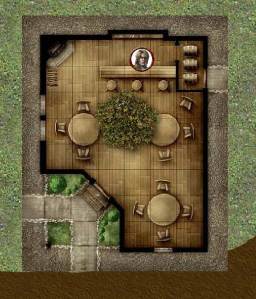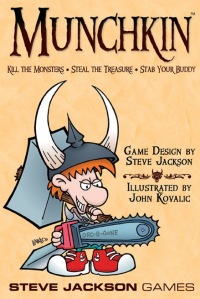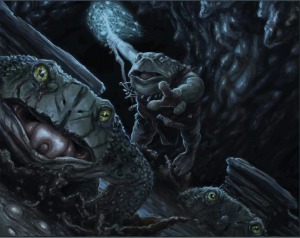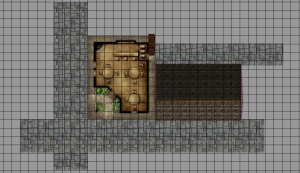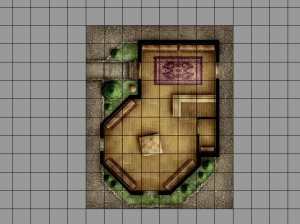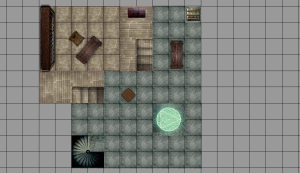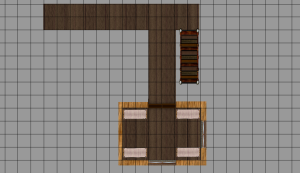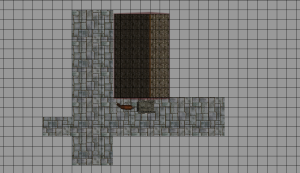Opportunity attacks can be hard for new players to understand. If you drop your guard by either walking away from a monster (rather than cautiously shifting a small distance) or doing certain things that take your attention elsewhere (making a ranged or area attack), the monster will get a free shot at you (a melee basic attack).
I like this rule. I can’t quite put my finger on why I like it, but I do. Maybe just force of habit, I suppose, but it feels “sensible” within the D&D world.
Thus, I’m a little bit annoyed by easy-to-access features of the game that shut off opportunity attacks. The biggest transgressors I’ve seen are Shadowdance and Shimmering Armor and the relatively new Staff Expertise feat.
Shadowdance Armor
Shadowdance Armor is available in cloth or leather, and it’s available as low as a 5th-level item. Now, it’s an uncommon, which means that the players only have access to it if the DM says so (thus, the DM can say, “Sorry, there’s no Shadowdance Armor in my game.”). It has a troublesome property in my mind:
“Your area and ranged attacks don’t provoke opportunity attacks.”
This is obviously a fantastic item for anyone who likes to make area or ranged attacks and doesn’t mind wearing cloth or leather armor. I think that would apply to lots of rangers, wizards, warlocks, sorcerers, etc.
The item annoys the heck out of me. If a PC uses a ranged or area power while standing next to a bad guy, unless they have something really cool about the power that makes it extra-defensive, the bad guy is going to get a free shot at them. Thus, they’ll need to figure out a way to get away from the baddie first, or maybe a way to make the free shot hurt (such as if the monster is marked by a defender) – or else just suffer the consequences. It’s part of the game, and I think it makes things more interesting.
Compare it in power level to the Razordark Bracers from Adventurer’s Vault 2 – a level 11 arms slot item for warlocks that says, “Your warlock at-will ranged attack powers don’t provoke opportunity attacks from adjacent enemies.” It only applies to warlock powers, it only applies to ranged powers (not area), it only applies to at-will powers (not encounter or daily) and it only applies to adjacent enemies (not farther-away foes with threatening reach). And that’s a level-11 item! I didn’t even mention that Shadowdance Armor also comes with a daily power (which, granted, I’ve not yet seen anyone use).
Shadowdance Armor is apparently from Seekers of the Ashen Crown, which is an Eberron adventure published in July 2009. I’ve never seen or played the adventure, and I don’t know how “integrated” it’s intended to be with the rest of the D&D world, but I’m comfortable saying that its armor just doesn’t exist in my universe in the future.
And for the character of Alayne in my Friday night campaign, don’t worry – she can keep her armor. Although I think it’s illustrative to note that when I theoretically bribed the warlock in my Friday night game with different leather armor that’s +4 instead of her current +2, she preferred to keep the Shadowdance. Yeah, it’s pretty optimal.
Shimmering Armor
Shimmering Armor is pretty much the same as Shadowdance, except that it’s only available in cloth and it doesn’t have the extra daily power. It’s available at 3rd level, and it’s from Adventurer’s Vault. I don’t like this one, either, though I’ll admit it’s a bit harder to justify it not existing in my world since it’s from a more core book like Adventurer’s Vault rather than a single adventure. Still, I can live with myself if I rule that it doesn’t exist.
Staff Expertise
Staff Expertise is the one that really bugs me now. This is one of the new expertise feats from Heroes of the Fallen Lands / Forgotten Kingdoms, and I generally love those feats. They add some flavor to a simple math bonus of a +1 to hit, and I’m a fan of that. Staff Expertise seems absurd to me, though. First of all, it gives +1 to the reach of your melee attacks. This isn’t going to come up all that often, but it will be nice every now and then.
Second, it gives you much the same benefit as Shadowdance or Shimmering Armor: your implement attacks made with a staff don’t provoke opportunity attacks.
Now, when I played a wizard as my first D&D 4th edition character (before the existence of Staff Expertise), he used a staff as an implement. I liked the idea that he could smack something if need be, and I liked the extra defense. But I know that lots of other wizards would use orbs or tomes or whatever.
Today, is there a reason for a spellcaster who CAN use the staff as an implement to use anything else? I think that making sure you never provoke an opportunity attack from casting a spell is a pretty huge incentive to be a staff wizard (unless you already have Shimmering Armor, I guess!).
Given that this one is a feat, it’s much more of a dick move for a DM to say, “Sorry, you can’t use this feat.” I’ll do it if I think it’s the right thing to do, but I feel guiltier about it. It’s right in the core Essentials books, after all.
Your thoughts
What do you think? Am I out of line for being annoyed with easy ways to prevent opportunity attacks? Am I wrong in thinking that these are no-brainer default choices for the appropriate character classes (if the DM allows them)? Are they TOO good?



